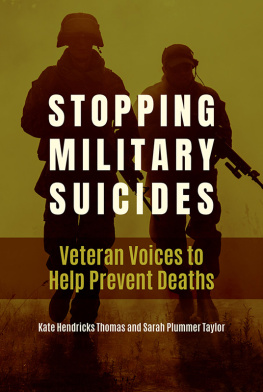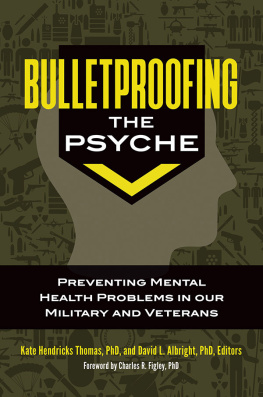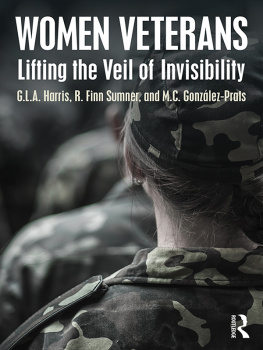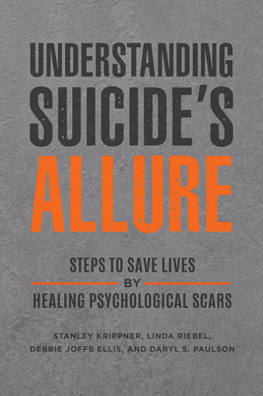Stopping Military
Suicides
Stopping Military
Suicides
VETERAN VOICES TO HELP
PREVENT DEATHS
Kate Hendricks Thomas and Sarah Plummer Taylor
Foreword by Patrick McGuigan

Copyright 2021 by Kate Hendricks Thomas and Sarah Plummer Taylor
All rights reserved. No part of this publication may be reproduced, stored in a retrieval system, or transmitted, in any form or by any means, electronic, mechanical, photocopying, recording, or otherwise, except for the inclusion of brief quotations in a review, without prior permission in writing from the publisher.
Library of Congress Cataloging-in-Publication Data
Names: Thomas, Kate Hendricks, author. | Taylor, Sarah Plummer, author.
Title: Stopping military suicides : veteran voices to help prevent deaths / Sarah Plummer Taylor and Kate Hendricks Thomas ; foreword by Patrick McGuigan.
Description: Santa Barbara : Praeger, an imprint of ABC-CLIO, 2021. | Includes bibliographical references and index.
Identifiers: LCCN 2020027355 (print) | LCCN 2020027356 (ebook) | ISBN 9781440875076 (hardcover) | ISBN 9781440875083 (ebook)
Subjects: LCSH: VeteransSuicidal behaviorUnited States. | VeteransMental health servicesUnited States. | SuicideUnited StatesPrevention. | Post-traumatic stress disorderPatientsTreatment.
Classification: LCC HV6545.7 .T46 2021 (print) | LCC HV6545.7 (ebook) | DDC 362.28/7086970973dc23
LC record available at https://lccn.loc.gov/2020027355
LC ebook record available at https://lccn.loc.gov/2020027356
ISBN: 978-1-4408-7507-6 (print)
978-1-4408-7508-3 (ebook)
25 24 23 22 211 2 3 4 5
This book is also available as an eBook.
Praeger
An Imprint of ABC-CLIO, LLC
ABC-CLIO, LLC
147 Castilian Drive
Santa Barbara, California 93117
www.abc-clio.com
This book is printed on acid-free paper 
Manufactured in the United States of America
To my beloved family and next-door neighbors, Lynn and Matt.
Thank you for being there for us the way you always have and
for being such a gift to Matthew.
Kate Hendricks Thomas
To my husband, Pete. You are my rock.
To my daughters, Lila and Brennan. Thank you for
choosing me as your mother.
Sarah Plummer Taylor
Contents
The topics covered in this book may be disturbing to some readers. Therefore, we want to share in advance that there will be discussions of suicide, mental health issues, and military sexual trauma in this book. Strong reactions are normal, and we understand that choosing what to read and what to skip is personal. Please practice self-care as you decide whether or not to read the science and stories in the coming pages. This book is not intended as medical advice, diagnosis, or treatment. As always, if you feel a need for resources, call the National Suicide Prevention hotline at 1(800)-273-8255. Veterans can access mental health resources at that phone number and identify as military-affiliated/veteran by pressing 1.
One cannot begin to solve a problem until it is understood; in order to understand it, you need to first identify and admit that you have a problem. This book identifies and explores the public health problem of veteran suicide, offering solutions through a community approach that cements the individual veteran at the center. With more than seven thousand veterans and servicemembers taking their lives every year for almost a decade, one can make a strong argument that we not only have a problem but also a crisis. Over the past ten years, federal funding increased by $6 billion and mental health care became more accessible, especially at the point of crisis in an attempt to reduce and prevent veteran suicide. This approach, although meaningful, achieved no effect in reducing and preventing veterans from taking their lives.
This book is about how to best identify the problem and begin to address it. A community-first approach, where everything begins, operates, and excels in and through the community, sets the foundation to finally address the problem before individual crisis. A community solution that enhances outreach through social and peer engagement, presented in a wrap-around resource manner, enables an upstream prevention model by offering a smooth transition back to civilian life. For the past ten years, programs and organizations viewed themselves as the sun, expecting the veteran to orbit around them. A true community approach, as described in this book, will place the veteran as the sun within the community and have organizations and resources orbit around them. It also considers the role the active duty component can play in getting veterans prepared for transition by strengthening individual levels of resilience prior to service separation.
My perspective was shaped and developed over the past eighteen months while traveling the country meeting with people and organizations, living and working in their communities. Consistently engaging with organizations helping veterans at the grassroots, tactical level provided me with a grounded perspective. In a unique way, learning about community interventions to prevent veteran suicide reminded me of my almost thirty months of conducting counterinsurgency (COIN) operations during the surges in Iraq and Afghanistan. My days were filled with meetings with village leaders and elders trying to establish and maintain security for the locals. There, I would walk the villages to capture the atmospherics and underlying issues that caused insecurity. Here, I was in the community trying to gain atmospherics and an understanding for what was triggering so many veterans to take their lives. What both of those experiences had in common was the realization that you truly cannot understand the issue and begin to address it until you live in and become part of the community. In addition to efforts within the DOD and Department of Veterans Affairs (VA), the resources of the local community must be part of any meaningful solution in the future.
As I parachuted into public service after over a decade of active duty military service, I approached the problem set from a perspective not as a doctor, mental health professional, scientist, or researcher, but rather from a leadership perspective. Through my public-service related travels, I consistently thought about how to get leadership from the private and public sectors at the national, state, and local levels more engaged on the issue. The takeaway from this observation is engaged leadership must exist, operate, and thrive in the community. The best community models had strong synergy of leadership in the community between private and public organizations. It is through these strong partnerships that enable communities to set a foundation allowing for a veterans smooth transition into civilian life. This transition is the critical first step to prevent suicide.
A smooth transition into the community is vital for a veteran and their family to start the new chapter in life on a positive trajectory. A transition supported by a community where its existing veterans and organizations provide means and ways to connect and join their tribe is an upstream way of preventing suicide. Strong, resilient communities provide an organized and synchronized approach to navigating and finding resources within the community to support the transition of a veteran. However, just because you have resources available does not mean they are effective in supporting the veterans transition. The resources need to be presented and offered in an organized manner, precisely applied at the appropriate time and in the right mechanism under accountable means in order to achieve the effect for which they are purposed.
















